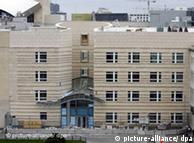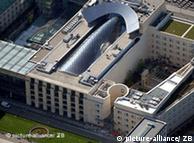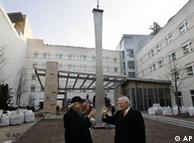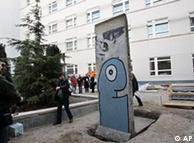看過 CNN對古城的報導 在再搜集這
Jaffa
Stone soup
May 15th 2008
From Economist.com
A history of destruction and restoration
Thursday
EYAL ZIV (pictured below) says he hears Jaffa's buildings talking to him. They all say the same thing, he laughs: “Please restore me”. As the architect in charge of Jaffa's renovation programme, he has plenty of work. Jaffa was neglected for decades after Israel's establishment in 1948. Manshiyyeh, once a mixed Arab-Jewish area bordering Tel Aviv, was bulldozed and turned into a park. Hundreds of villas in Ajami were demolished. Jaffa was incorporated into Tel Aviv—a peculiar irony, as a century ago Tel Aviv began life as a suburb of Jaffa.
Recently, however, Tel Aviv launched a multi-million dollar programme to renovate Jaffa, which is blighted by high crime, drugs, gangs and unemployment. The programme is part social improvement and part urban makeover. Eyal is restoring Jaffa's unused train station, while the old port is being turned into a chic waterside neighbourhood.
Eyal grew up in Old Jaffa and works with his childhood friend, Fayeez Abu-Nasser, a stonework specialist. They share a passion for the city. “Even if we don't do a good restoration, we can make a good relationship between Jews and Arabs and all the people here,” says Eyal. “To do things correctly, with the people, to ask their opinion and work with then, not against them.”
Their first project was restoring Jaffa's clock tower, one of more than a hundred built across the Ottoman Empire a century ago by Sultan Abdel Hamid II. Eyal and Fayeez then started work on the surrounding piazza and the neighbouring shops. Five years ago, the square was run-down and grimy. Now chic boutiques and crowded cafes flank the tower.
In fact this is not gentrification, but re-gentrification, say Jaffa's Arab inhabitants—a reminder of the city's pre-1948 glory days. Eyal says he tries to avoid politics and focus on the buildings. Each project is preceded by meticulous research, using old books, maps, photographs and archive materials. “If you want to restore something then do it exactly like it was. It doesn't matter whether it was Palestinian, British, or Turkish. The city is like a book, when you open the book you see its pattern. That's my responsibility, to do it very straight and very honestly.”
Still, the Israeli-Palestinian conflict means Eyal and Fayeez are working in a political minefield. Each building was once fought over, and their histories are still contested. In November 1947, the Jews accepted the UN’s plan to partition Palestine, but the Arabs rejected it. Fierce fighting erupted immediately between Jaffa and Tel Aviv, especially along the border area. Elderly residents of Tel Aviv still recall Arab snipers shooting into the city each night from Jaffa. Both sides bombed and terrorised civilians.
In January 1948 the Stern Group, the extreme Zionist militia, blew up the New Seray building on the corner of Clock Tower Square, home to Jaffa's municipal offices and a soup kitchen for poor children. Dozens were killed or injured. The mass Arab exodus began, especially of the middle-class and urban elite, which could have provided communal leadership in the testing days to come.
The remains of the New Seray stood empty for decades. Eyal and his team took an innovative approach to its restoration. They rebuilt the 19th-century neoclassical facade and the neighbouring building, soon to be the Turkish cultural centre. The area to its side is now a pleasant open space with stone benches and palm trees, cooled by the sea breeze. Its borders precisely match the building’s former walls. The urban space remains but its usage evolves. One day, says Eyal, the New Seray may be completely rebuilt; removing the benches to make space for new construction would be easy.
In a region deeply polarised by history and conflicting narratives, Eyal enjoys a rare, philosophical perspective on his work. “This is history, the destiny of the city. Its rulers all build and destroy. First the Turks, then the British and then the Israelis. We are starting not just to rebuild things but to connect them together again. Because Jaffa has to be the place where Jews, Muslims and Christians can connect, like they used to.”
Back to top >>
Wednesday
THE Yafa Café is just north of the Old City. Founded in 2003 by Dina Lee, a Jewish woman from Jaffa, and Michel el Rahab, an Arab businessman from Ramle, the Yafa Café is dedicated to dialogue and co-existence; it sells books in Arabic, Hebrew and English.
It's a tiny place, with barely half a dozen tables, good coffee and great food, but its reputation is growing: in January 2008, the New Israel Fund, which supports co-existence projects, awarded the café the first Israela Goldblum Prize, worth $15,000.
The cafe also hosts lectures and discussions, and offers Arabic courses. Dina and Michel call the café a reminder of Jaffa’s glory days, before 1948, when about 90,000 Palestinians fled or were driven out, depending which history books you read. Dina and Michel say they will use the Goldblum money for more Arabic teaching, and to create an archive for books, documents and photographs about Jaffa.
The Yafa Café is a cherished place in Israel: Jews, Muslims and Christians are all welcome; they share tables and discussions (full disclosure: I read from my book here to a gratifyingly heavy turnout). Its regulars include observant Muslims, like Safa Younes (pictured), and Yudit Ilany, a Jewish social activist. Safa studied women's and gender issues at Tel Aviv University and worked for six years as a probation officer in Tel Aviv and Jaffa—an unusual career for a young Muslim woman. Her clients included numerous drug dealers and criminals.
She helped found a new Arab women's organisation in Jaffa called Urs al-Bahr—“the bride of the sea”, Jaffa's former name. Urs al-Bahr is based in an apartment in Ajami, a run-down quarter of Jaffa, which is blighted by high levels of poverty and unemployment. Arab women in Israel have two major problems, says Safa. “Firstly, that they are women, with less rights than men, and secondly that they are part of a national minority, as Arabs in a Jewish state. We want to change that, not from the top, but from the bottom up.”
Thanks to places such as Yafa Café, Jaffa's younger Arab generation is finding its voice, and a space in Israel's lively civil society. “The Arab women of Jaffa need their own place, to learn computer skills—almost nobody among them knows how to use a computer—to take courses in Arabic literacy and English. A place that they can feel is their own. We tried to make Urs al-Bahr like someone's home, so the women would come because it is a feminine space.”
Yudit, a close friend of Safa's, is also a regular at the Yafa Café, when she is not battling Amidar, the Israeli state housing company. In the last few years Amidar has issued 200 eviction notices and three hundred requests to “amend their legal rights” to families in Jaffa and its environs. Most are Arabs. Property prices are booming in Jaffa, thanks in part to the millions being spent by Tel Aviv to improve schools and infrastructure.
Ajami may be rough, but its stunning beach makes it a desirable area. Yudit took me to meet the Hatabs, who face potential eviction. The Hatabs say they have owned their home for six generations, long before Israel even existed. Youssef Hatab shows me a document signed in 1952 by his grandfather. It's a rental contract for his own home, which had been appropriated by the state. But Mahmud could not read or write Hebrew and signed with his thumbprint, surrendering his rights.
The activists argue that Amidar wants to kick out Arab families out of Ajami because they are getting in the way of developers. Amidar counters that the Hatabs illegally built an extra eight rooms without planning permission and failed to pay rent for them. Amidar argues this is all a simple matter of law, and only the activists are making this into a political issue. But in Jaffa, housing and new developments are always political.
Either way, the Hatabs are being squeezed. New residential developments loom over the one-storey family compound, just inches from their property line. Whatever the legal rights and wrongs of their case, it's extraordinary that planning permission for the neighbouring developments was ever granted. It's hard not to see the walls squeezing the Hatab family as a metaphor in bricks and concrete for Jaffa's poor Arab families.
Back to top >>
Tuesday
A SHORT walk from Old Jaffa is a narrow alley known as the Street of the Money Changers. It was here in the late-nineteenth century that the Chelouche family set up shop after emigrating from North Africa. The family patriarch, Aharon Chelouche, was a money changer and jeweller. Coins then were often made partly of silver or gold, and Aharon knew precisely how much metal each coin contained, when to melt them down and when to sell. There is still a grill over the shop's door to let the fumes escape when metal was melted down.
With his profits Aharon bought large tracts of land around Jaffa. Back then the price of a plot was set in throws of a stone—the buyer would hurl the stone as far as he could, repeating the action until he had covered enough land. Aharon soon became an expert stone-thrower.
AFP The orange city
The orange city Towards the end of the nineteenth century Aharon sold some of his land for the construction of Jaffa's first Jewish neighbourhood. The city could no longer house the waves of Jewish immigrants pouring into the Holy Land. According to family legend, that land became the settlement of Neve Tsedek, which is now part of Tel Aviv.
Aharon Chelouche built a large Arab-style house—one storey with a spacious hall and rooms leading off it—where he, his wife and children lived. The family was part of the elite of the Yishuv, as the Zionist-state in the making was known, but nurtured good relations with the Ottoman authorities. When Aharon Chelouche's carriage overturned in a wadi, a dried out riverbed, the governor of Jaffa built a bridge for him.
One son, Yaakov, became the treasurer of the Anglo-Palestine Bank, which financed the Jewish settlements. Yaakov was always preceded on his rounds by his kawas (bearer), who wore a special uniform and carried a polished baton, with which to hit the ground and clear a path for his master. Yaakov’s brothers, Yosef Eliahu and Avraham Haim, owned a construction company and a factory that supplied tiles and housing materials.
The Chelouches were Sephardi Jews, whose ancestors had fled Spain in 1492 for north Africa. They enjoyed good relations with their Arab neighbours. They ate the same food and spoke Arabic, not Hebrew, at home. They were astute businessmen, socially conservative but engaged with the world, and well-versed in manners and mores of the Levant. When Yaakov visited a client who owed the bank money, the debt was never mentioned. Instead he gossiped about the neighbourhood, the orange crop and their families.
Marriages were arranged—not forced, but encouraged—and the Chelouches intermarried with the Moyals, another dynasty of Jaffa’s Sephardi Jewish elite. Josef Moyal was granted an honorific title by Sultan Abdul Hamid II for his help building Jaffa’s clock tower at the start of the twentieth century. His son, Shimon Moyal, sat on Jaffa’s city council and translated the Talmud into Arabic. The Sephardi Jews hoped to be a bridge between the new immigrants and the Palestinians. Josef’s grandson, Avraham Moyal, who lives in Jerusalem, still describes himself as a “Jewish Palestinian”.
But the Moyals and the Chelouches were soon marginalised by the Yishuv's leadership. The Ashkenazi Jews from eastern Europe and Russia knew no Arabic and had no interest in learning it. Most were socialists or Communists and distrusted the Sephardim. The Ashkenazim ignored their carefully-nurtured relationships with the Arab grandees.
Yosef Eliyahu Chelouche despaired of the Zionists leadership’s insularity. The Yishuv, he wrote in his autobiography, considered every factor except one: the Arabs who lived in Palestine. “During this period of building our country we know nothing about Arab customs, habits, manners, tribes and social trends, their economic and cultural situation and more. In all the Zionist literature there is not even one book that would describe these people's lives accurately or contain genuine information about their situation.”
Aharon Chelouche's house still stands on the street in Neve Tsedek named for his family, and is about to be restored. Faded lettering is visible above the entrance: Frères Chelouche, and in Arabic, Ikhwan Chelouche (Chelouche Brothers).
The governor’s bridge still spans the wadi, which is now a car park. Like the Palestinians, the Sephardi Jews are part of Jaffa’s lost, or marginalised, history. How different that might have been had the Chelouches and the Moyals been able to bridge the divide between the Ashkenazim and the Palestinians.
Back to top >>
Monday
I FIRST visited Old Jaffa, the heart of the ancient city, about twenty years ago. I walked down narrow lanes and stepped alleys, all carefully restored and turned into an artists' quarter, crowded with tourists perusing the paintings and jewellery. Our guide related the Israeli version of Jaffa's history: the prophet Jonah vainly fled God from here; the ancient port was taken by the Pharaohs, the Romans, the Hebrews, the Byzantines, the Ottomans, Napoleon, the British, and then finally, in May 1948, by the Israelis. I returned last month to make “Jaffa Stories”, a film for the BBC.
Old Jaffa still dazzles, but for all its beauty something is missing: the original inhabitants. Old Jaffa is a city of ghosts. This week Israel celebrates its 60th anniversary, which the Palestinians remember as the nakba (the catastrophe). Jaffa, known in Arabic as Urs al-Bahr (Bride of the Sea), was the cultural capital of Palestine. It was home to publishing houses, newspapers, cinemas, theatres, sports teams and social clubs.

Jaffa boasted a thriving Arab middle class, proud of their Palestinian heritage but rooted in the modern world. It had a complex and deep relationship with Tel Aviv, the neighbouring Hebrew city. Jaffa's pillars were men like Ahmad Hammami, a scion of an old Jaffa family who, like many Jaffans, worked in the orange business. The city smelled of citrus; the groves stretched for miles all around. Ahmad built a large stone villa on the southern tip of Jaffa, in an area called Jebaliyyeh. He lived next door to his cousins, and the two houses shared a lush fruit garden, from which Ahmad’s wife, Nafise, would make jam.
That world ended quickly in April 1948. Jaffa was awarded to the Arab side in the 1947 United Nations partition plan—an Arab island surrounded by Jewish territory. The mainstream Zionist militia, the Haganah, had no plans to attack, believing that the city would surrender. And indeed its mayor was already negotiating with the Zionist leadership. But Menachem Begin, leader of the right-wing Irgun, wanted to capture Jaffa to build his political capital in the already simmering rivalry between the left and right wings of the Zionist movement.
So at the end of Passover the Irgun launched a rain of mortars onto the ancient port. Tens of thousands of Palestinians fled. Perhaps unnecessarily—for the attack stopped after three days when the British, still the Mandate power, intervened. Even now those few thousand Arabs who stayed will argue that Jaffa was abandoned, even betrayed, by its inhabitants.
But hindsight is an easy virtue, and those were days of terror. So much so that Ahmad Hammami, who had planned to stay, came home and put his family into a taxi and sped to the port. They packed what they could as the mortars rained down, grabbed some jewellery, rolled up some Persian carpets and squeezed themselves onto the SS Argentina. It took them three days to reach southern Lebanon.
While researching my book, “City of Oranges”, which tells the lives of Arab and Jewish families in Jaffa, I became friends with Hasan Hammami (pictured above, at right), Ahmad's son. He is now in his seventies and lives in the United States. Hasan wrote his memoirs and shared them with me. They are a poignant, moving account of a life spent in exile, of career and material success that fail to compensate for the loss of a homeland. Hasan's book resembles nothing so much as the memoirs of Jewish exiles from pre-Holocaust Europe, a longing for a rich and vanished world.
I also came to know his sister Fadwa and his daughter Rema, who live in East Jerusalem. One day Fadwa and Rema took me to the Hammami villa. It is now an Israeli old people's home. The rooms have been chopped and divided by cheap aluminium partitions and an institutional smell lingers. Concrete covers the garden; the fruit trees are gone.
The suburb of Jebaliyyeh has been renamed Givat Aliyah—hill of aliyah, meaning immigration to Israel. Still, the Hammamis return, especially when a new baby is born. I learnt a lot that day about the experience of exile and dispossession, one thing at least that Jews and Palestinians can share. Ahmad Hammami never saw his home again after 1948. But his stone villa still stands, a mute and still-elegant reminder of a lost world, of Jaffa’s glory days before the nakba.






















